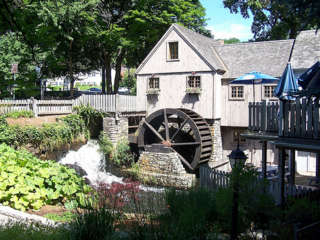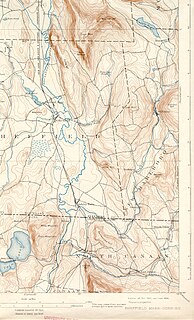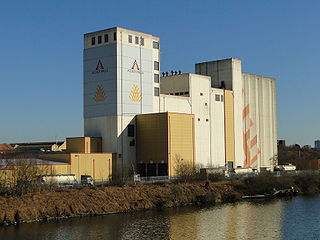
North Scituate is a census-designated place (CDP) in the town of Scituate in Plymouth County, Massachusetts, United States. The population was 5,077 at the 2010 census. It was formerly known as Gannet Corner.

Augusta is a town in Oneida County, New York, United States. The population was 2,020 at the 2010 census.

Scituate is a census-designated place (CDP) in the town of Scituate in Plymouth County, Massachusetts, United States. The population was 5,245 at the 2010 census.

Scituate is a seacoast town in Plymouth County, Massachusetts, United States, on the South Shore, midway between Boston and Plymouth. The population was 18,133 at the 2010 census.

Watson's Mill is an historic flour and gristmill in Manotick, Ontario, Canada. It is the only working museum in the Ottawa area and one of the very few operating industrial grist mills in North America. Watson's Mill still sells stone-ground whole wheat flour which is made on site. The mill is also well known for its ghost Annabelle. The legend is that Ann Currier, wife of Joseph, haunts the mill, following her death in a tragic accident there in 1861. Watson's Mill is Manotick's most recognized landmark. Its image is used as a symbol for the village.
Bar Rock42.241°N 70.758°W is a barren rock within Massachusetts Bay, in Scituate, Massachusetts, USA. The rock is just east of the Scituate neighborhood of Minot, off the coast of Scituate Neck. More specifically, the rock is east of the Bailey's Causeway & Glades Road intersection.

Old Sturbridge Village is a living museum located in Sturbridge, Massachusetts which recreates life in rural New England during the 1790s through 1830s. It is the largest living museum in New England, covering more than 200 acres. The Village includes 59 antique buildings, three water-powered mills, and a working farm. The museum is popular among tourists and for educational field trips. Costumed interpreters speaking in modern English help visitors understand 19th-century life.

Minot is a section of Scituate, Massachusetts. Minot's ZIP Code is 02055.

The Old Schwamb Mill is historic 19th-century mill at 17 Mill Lane in Arlington, Massachusetts. It claims to be located on the oldest continuously-used mill site in the United States, with a documented history of operation dating back to about 1684. The current mill building, erected in 1861, is now a living history museum. The property was listed on the National Register of Historic Places in 1971.

The Plimoth Grist Mill is a working grist mill located in Plymouth, Massachusetts. It is a reconstruction of the original Jenney Grist Mill, and it stands on the site of the original mill.

The North River is a river, approximately 12 miles (19 km) long, in eastern Massachusetts, the United States. It is primarily a tidal river, formed by the confluence of the Indian Head River and Herring Brook. The North River forms the boundary between the towns of Norwell, Pembroke, Massachusetts, Hanover, Massachusetts and downstream, the boundary between Scituate and Marshfield. The river flows into Massachusetts Bay at New Inlet, where it also converges with the mouth of the South River. The North River area is also known as the "Irish Riviera" due to the large Irish American population that migrated during the 19th century.

The Bookmill is an independent bookstore in Montague, Massachusetts. The 1834 grist mill it occupies is listed as the Alvah Stone Mill on the National Register of Historic Places.

The Konkapot River is a 22.1-mile-long (35.6 km) river in southwestern Massachusetts and northern Connecticut. It is a tributary of the Housatonic River, not to be confused with the smaller Konkapot Brook in Stockbridge.
Humarock is part of Scituate, Massachusetts, United States 42°08′10″N70°41′26″W. Humarock is a picturesque seaside village surrounded by water and situated on Cape Cod Bay midway between Boston and Plymouth. It was separated from the rest of the town in the Portland Gale of 1898 in which the mouth of the North River shifted. Humarock is now accessible from Scituate only by boat or from the Town of Marshfield by bridge.

A gristmill grinds cereal grain into flour and middlings. The term can refer to either the grinding mechanism or the building that holds it. Grist is grain that has been separated from its chaff in preparation for grinding.

Henry Ford's Village Industries were small factories located in rural areas of Michigan. Ford developed his Village Industries in part to provide farm workers a stable source of income during the winter months.

The Gooseville Mill/Grist Mill is a historic mill on the North Branch Milwaukee River in Gooseville, Wisconsin. The mill was built in 1879 to replace an 1855 mill that had burned down. The mill is a small custom mill with board and batten siding and is typical of the custom mills common in Sheboygan County in the 1800s. A Lefel turbine powered the mill, replacing the paddle wheel used in the 1855 mill. A burr mill was used to grind the grain processed at the mill. As of 1984, the mill was still operational and occasionally used as a sawmill.
Scituate Proving Ground was a proving ground of the United States Army located in Scituate, Massachusetts. It became operational in 1918, when 115.25 acres were purchased between June and July. In November 1919 the site was declared excess, and it was used as a storing ground until June 1921. During its brief period of operation it was intended to proof fire the production of 155mm and 240mm howitzer carriages that were built elsewhere in Massachusetts. The proving grounds in Scituate did not have the ability to test the projectiles or fuses, so it was used to test cartridge cases, primer and powder. The grounds had its own heating and power plants as well as a garrison of 10 officers and 130 enlisted men. Recently, the site was used for housing, although former structures dating from the use of the grounds could be seen up until 2018, when the Toll Brothers began to develop the site. Toll Brothers plans to build "Seaside at Scituate", which will have 142 townhouses in a condo setting for people 55 years and older when completed.
Mill Creek is a stream in Oregon County in the Ozarks of southern Missouri. It is a tributary of Barren Fork.















